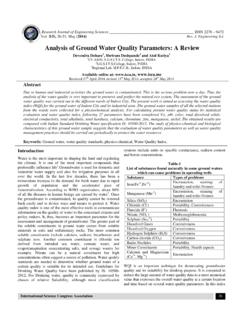Transcription of Irrigation and Water Management - Food and …
1 Policy Highlights Irrigation and Water Management Module 027 Policy Highlights Irrigation and Water Management by the Agricultual Policy Support Service, Policy Assistance Division, Rome, Italy based on Agricultural Development Policy: Concepts and Experience by Roger D. Norton for the Food and Agriculture Organization of the United Nations, FAO About EASYPol EASYPol is a an on-line, interactive multilingual repository of downloadable resource materials for capacity development in policy making for food, agriculture and rural development. The EASYPol home page is available at: EASYPol has been developed and is maintained by the Agricultural Policy Support Service, Policy Assistance Division, FAO. The designations employed and the presentation of the material in this information product do not imply the expression of any opinion whatsoever on the part of the Food and Agriculture Organization of the United Nations concerning the legal status of any country, territory, city or area or of its authorities, or concerning the delimitation of its frontiers or boundaries.
2 FAO January 2006: All rights reserved. Reproduction and dissemination of material contained on FAO's Web site for educational or other non-commercial purposes are authorized without any prior written permission from the copyright holders provided the source is fully acknowledged. Reproduction of material for resale or other commercial purposes is prohibited without the written permission of the copyright holders. Applications for such permission should be addressed to: Irrigation and Water Management Policy Highlights 3 Table of Contents 1 1 2 Water : a scarce economic resource .. 1 3 Recent trends in Irrigation .. 2 4 Key policy concerns .. 3 5 Strategic policy issues .. 4 The macro and agricultural policy 4 Intersectoral resource 4 Investment and technological 5 6 Sector development policy issues .. 5 7 Managing Irrigation Water demand.
3 6 8 Pricing Irrigation Water .. 7 9 Creating Water rights markets .. 7 10 Local Management and Water users associatons .. 8 Module metadata .. 10 Irrigation and Water Management Policy Highlights 3 1 1 INTRODUCTION Over billion people worldwide depend on Irrigation for food, employment and income. Since the early 1960s, over a million ha of new irrigated land have been created. By the late 1990s, irrigated agriculture in developing countries accounted for around 200 million ha or a fifth of total arable area, contributing to 40% of all crop production and nearly 60% of cereal production. Over the next three decades, a further 40 million ha of irrigated land are expected to be developed, and Water withdrawal increased by some 14%. Greater use of intensive irrigated agriculture would place enormous strains on available Water resources.
4 It could also lead to environmental degradation such as salinisation and waterlogging, and increasing conflicts between users. In some regions, irrigated agriculture is fast approaching its full potential. FAO estimates that by 2030 East Asia and North Africa will be using three-quarters of their irrigable area. For South Asia (excluding India) this is expected to be closer to 90% of total irrigable area. 2 Water : A SCARCE ECONOMIC RESOURCE Supplies of freshwater that are economically available worldwide are estimated at 9,000 14,000 km3 per annum. Total annual Water withdrawal for agriculture, industries and domestic use stands at some 3600 km2 globally. Including surface Water that must be left to follow its natural course to ensure effluent dilution and safeguard the aquatic ecosystem, the amount already subscribed for human and ecological needs is of the order of 6000 km3, a significant proportion of resource availabilities.
5 With population growth and increasing demands, Water supplies are tightening on an unprecedented scale, with scarcity already critical in some countries and regions. An FAO analysis indicated that some 36 countries out of 159 surveyed were already Water stressed in 1998, with 20 countries in a critical condition. Physical scarcity asides, harnessing and distribution of Water involve real costs. Accessing the next unit of Water becomes costlier (from having to dig deeper or convey further): so too should society need to pay more for this commodity. Because of competing demands on its use, the question of scarcity value and economic pricing takes on additional significance. But as yet, not all countries have taken adequate account of these factors in the planning of Water systems or in allocation of supplies.
6 Past policy failures at the macro and sectoral levels have led to gross inefficiencies in Water resource use, including misuse, overuse and undue waste, with undesirable long term consequences for crop production, the environment, and food security (see Box 1). Thematic Overview EASYPol Module 027 2 Box 1 - Consequences of Water overuse: Impact on the Aral Sea Over a period of just three decades from the early 1960s, witdrawal for irrigated cotton production and construction of flood storage reservoirs havedrastically reduced annual inflow into the Aral Sea. This led to the decline in sea level by 16 metres, and reduction of lake volume by three-quarters. Twenty of twenty four fish species, along with fish catches which totalled well over 40 000 tonnes a year in the 1950s, have disappeared; low river flows have concentrated salts and chemicals, making Water hazardous to drink and harmful to human health; toxic dust-salt from dried up areas have deposited on surrounding farmland, killing crops.
7 Thos e who remain in the area have lost their main livelihoods, while others who left have become environmental refugees. Many countries are using more than their renewable Water supply, hence are in effect mining the resource. Ground Water mining is as much as 80% of total Water withdrawal in some areas: clearly a non-sustainable activity. More than a dozen countries have renewable Water supplies at less than 1000 m3 per capita per year, a level at which Water availability becomes a severe constraint on development and poses real hazards for the environment. Countries are said to be Water stressed when more than 20% of renewable Water resources are abstracted for agriculture. Water availability becomes a critical issue when 40% or more of renewable Water resources is used for Irrigation at around this level countries begin to have to make difficult choices between allocation to agricultural or urban sectors.
8 3 RECENT TRENDS IN Irrigation It needs little reminding that Irrigation worldwide has witnessed many instances of failed projects, inappropriate system design, ineffective Management , low Irrigation efficiencies, and systems deteriorating from insufficient cost recovery and poor operations and maintenance. But important lessons are being learned, and there is growing recognition of the need to tackle past weaknesses, both at planning and operation stages, in order to improve the efficiency, productivity and sustainability of Water use. Though still limited, there are now success stories in improved system performance, as apparent from the experiences of countries as diverse as Mexico, Turkey, and Mali. Notable here is the shift from past emphasis on supply augmentation to demand Management in Irrigation and Water use.
9 There is a growing body of evidence that adequate cost recovery for operations and maintenance can be achieved through participation of farmer- Water users in planning and managing Irrigation schemes. Full or close to full cost recovery for operations and maintenance is achieved in schemes in Mexico, Chile, Turkey, Tunisia, Mali and Ethiopia. The best results appear to be where Water is delivered on demand (Chile, Mexico, Egypt) and users have a high degree of responsibility and control over Irrigation and Water Management Policy Highlights 3 3 maintenance issues like annual budgets, Irrigation fees and procurement (Mali, Ethiopia). What is also clear is that Irrigation system enhancement needs to be supported by policies and institutions that would provide the correct price signals for investment decisions and adequate incentives for agricultural producers.
10 For instance, expanded production of high value irrigated crops in Chile was linked to incentives from the opening up of the country s economy in the early 1980s. For Mexico, access to urban markets from trade liberalisation, including the emerging NAFTA negotiations, provided a stimulus for efficient agricultural production and development of new markets. 4 KEY POLICY CONCERNS Whilst the concern of decision makers in Irrigation and Water Management may be primarily on resource use efficiency, taking a holistic view of Water as a natural and scarce economic resource is also predicated. Without factoring in the range of stakeholder and environmental interests, any efficiency gains may be transient and prove administratively unworkable in the long term. The overarching objectives of Irrigation and Water Management policies are: Improving efficiency of Water use.













